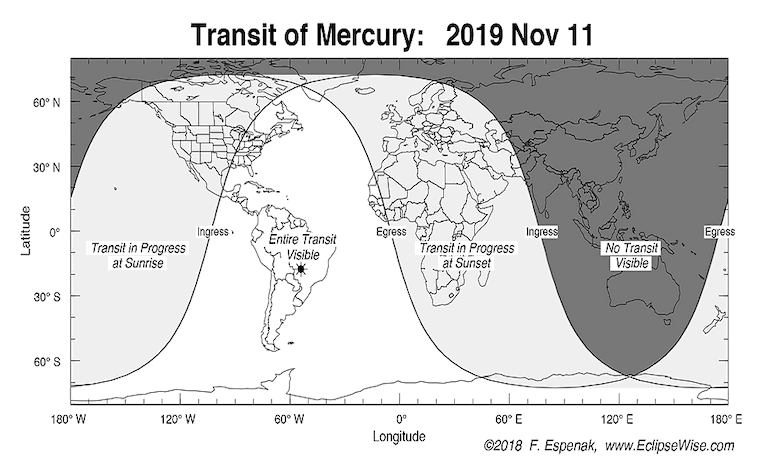Mercury Transits The Sun November 2019

Mercury will transit between the Earth and the Sun on November 11, 2019. Read on learn more about this upcoming event.
It has been since 2016 that Mercury has transited the Sun. The transit or passage of a planet across the face of the Sun is a relatively rare occurrence. Furthermore, from standing here on Earth, only transits of Mercury and Venus are possible. There are approximately 13 transits of Mercury each century. Watching a planet transit happen can take some time and specialized equipment. Below are some helpful tips and other information needed before November 11. Plan to try and see this one because the next transit of Mercury won’t happen until November 2032.
Mercury Transit Contact
When Mercury passes in front of the sun, it is measured in phases called contacts. There are four contacts during the transit. In the first contact, Contact I, the planet is when the planet’s disk is externally tangent to the Sun. When we are speaking of circles, it is helpful to know the definition for an external and internal tangent.
Two circles are externally tangent if they share a single point, and no point of one circle is on the disk created by the other circle. The circles are internally tangent if they share a point and all the points of one circle lie on the disk created by the other circle.
Towards the end of Contact I, the Sun appears to have a small notch cut out of its side. At the point of Contact II, the planet, in this case, Mercury, will be internally tangent. For several hours, Mercury will transit the Sun. When Mercury reaches the far edge of the Sun, that is called Contact III. At the point where Mercury is externally tangent, that is called Contact IV.

Credit F. Espenak 2019
The transit will be widely visible from most of Earth, including the Americas, the Atlantic, and Pacific Oceans, New Zealand, Europe, Africa, and western Asia. None of the transit will be visible from central and eastern Asia, Japan, Indonesia, and Australia.
Observing Mercury Transit Safely
Anytime a person looks at the Sun; they should do so wearing eye protection. In the case of observing Mercury’s transit, one must use a telescope. Since Mercury is only 1/194 of the Sun’s diameter, a telescope with a magnification of 50x or more is recommended to watch this event. The telescope must be suitably equipped with adequate filtration to ensure safe solar viewing. The visual and photographic requirements for the transit are identical to those for observing sunspots and partial solar eclipses. (Espenak, 2019) To see the transit with a telescope, make a Sun Funnel.
- When aiming a telescope toward the Sun, never use the finder! Keep it covered.
- Rely on the shadow of your scope’s tube. When it’s as compact as can be, and the eyepiece is brightly illuminated, you’re on target.
- Use a white cardboard sheet to project the solar image.
- Position the cardboard sheet about a foot from the eyepiece.
- Focus until the bright circle of light (the Sun’s projected image) is sharp at the edges.
Remember, that unless you have a Hydrogen-alpha filter on your telescope, do not look into the eyepiece.
People can also use binoculars that have filters on them. However, even at a 7x or 10x magnification, Mercury will look like a sunspot.
The total transit time for Mercury to make its way across the Sun will take approximately 5 1/2 hours. If you happen to live in the part of the world that can see the transit and you have a special telescope or binoculars, you can enjoy this rare event.
